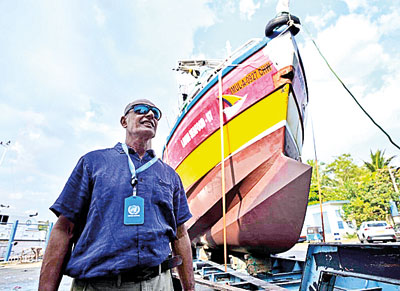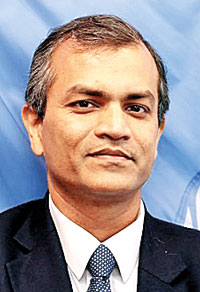News
FAO regional conference: Resounding success a big plus for Lanka, says Country Rep.
View(s):- Spells out game changing project for fisheries sector and new projects to boost agriculture sector
By Namini Wijesdasa
The Food and Agriculture Organisation (FAO) is mooting a proposal to attract funding of US$ 75-100mn to soften the impact of and help Sri Lanka’s fisheries sector adapt to climate change.
If approved, the project will be a “game-changer”, said Vimlendra Sharan, the Colombo-based FAO Country Representative for Sri Lanka and the Maldives. It will allow the FAO and government agencies to address the sector’s issues, comprehensively—a significant leap from the prevailing model of implementing smaller pilots of US$ 5-10 million.

The bulbous boat, pictured with the FAO naval architect who designed the bulbous bow for 50ft boats and the climate-resilient fishing boats for small-scale fishers. (Source: FAO)
The Green Climate Fund (GCF) is being tapped for the initiative, Mr. Sharan said, emphasising that it could take “a year or two” to come to fruition following an exhaustive technical review. A concept note—outlining objectives, methodology, expected results and budget—has received Sri Lanka Government approval.
A multi-stakeholder meeting will take place in early March as a step towards preparing a project report. Once the GCF Secretariat is satisfied, it will go to the board for sanction. GCF was established under the UN Framework Convention on Climate Change as the main financial mechanism to assist developing countries to counter climate change.
Resounding success of regional conference
This week, Sri Lanka hosted the 37th session of the FAO’s regional conference for Asia and the Pacific (APRC37), attended by 40 countries who agreed that their main challenges relate to the region’s ability to increase productivity and innovation alongside limited resources, climate change risks and growing populations. And they called for “transparent, predictable, open and fair markets, underpinned by an effective multilateral trading system”.
On the final day, delegates had a field trip to observe work that Sri Lanka has done in agriculture. “It is important to understand that the country has gone through a very lean phase in the last two to three years and it continues,” Mr. Sharan told the Sunday Times. “It is in recovery mode but I would not say it has totally recovered.”
“Given this background and context, the fact that over 250 delegates came to the country is itself a show of confidence that the global community has in Sri Lanka to host and take the leadership role in these areas,” he said. “It’s a big plus for Sri Lanka. It wasn’t as if people shunned it, thinking that nothing can happen.”
The attendance of nearly 25 ministers was “a record of sorts” for the Asia-Pacific regional conference. There was also a strong, larger-than-usual delegation sent by the FAO headquarters. “The idea was for them to interact and understand the genuine requirements of the region so that a good planning exercise can be done,” Mr. Sharan explained.

Vimlendra Sharan: FAO's Country Representative in Colombo
FAO’s new projects in Sri Lanka
In May 2022, Sri Lanka’s president wrote to the FAO director-general seeking help to tide over the country’s crisis. The organisation, along with its major funding partners like—USAID, Australia’s Department of Foreign Affairs and Trade (DFAT), the European Union (EU), Japan, New Zealand, etc.—contributed with nearly US$ 55mn in assistance.
The FAO is now transitioning from emergency to development—such as through its US$ 10mn “Rice Rethink” programme which aims to increase paddy yield which, at the moment is as low as 4.5 metric tons per hectare.
“Even if we raise it to, say, 5.5 metric tons, it will help us take out over 100,000 hectares of unproductive, marginal paddy land and to give that to a different crop,” Mr. Sharan said, reiterating that the objective is both enhanced paddy productivity and crop diversification. “This is a complete ecosystem involving everything connected around paddy.”
Advanced technology has been brought in. Drones will be deployed with USAID assistance for paddy seeding and fertiliser application, as pilot projects. The FAO is also finalising with the EU an initiative to reduce food loss and waste. Sri Lanka, while bountiful in production, continues to throw nearly 35-40 percent of its fruits and vegetables.
If the drone technology succeeds, it will also address productivity shortfalls caused by diminishing, costly labour. “We are looking at drones as equipment which will help increase productivity,” Mr. Sharan elaborated. Among other things, cameras will capture the colour of leaves and analyse crop conditions, allowing decisions to be made about what chemicals or fertiliser should be applied.
The FAO is also working with the Sri Lanka Government and Japan on a US$ 3mn “self-sustained, culture-based inland fisheries programme” which will establish four mini-hatcheries to supply fingerlings to irrigation tanks. A successful pilot was carried out in Ampara.
On the policy side, FAO helped Sri Lanka modernise its Fisheries Act—an EU requirement to ensure fish exports do not suffer. It is ready for Cabinet approval.
Under the GCF and Green Environment Fund (GEF), a US$ 5mn project is being looked at that will study soil conditions and the climatic impact on rice. And GCF has sanctioned a US$ 3mn project to reduce how much fertiliser and chemicals that are applied on land are getting washed into the sea, damaging marine life and coastal biodiversity.
FAO has also helped develop a “bulbous bow” attachment—something seen on every commercial ship, nowadays—for Sri Lanka’s 50ft multi-day fishing fleet. The bulb modifies the way the water flows around the hull, reducing drag and thus increasing speed, range, fuel efficiency and stability.
A typical fishing trip is about 50 days, with travel of over 2,500 nautical miles. It is expected that the bulbous bow will cause a 14-18 percent fuel saving. Designed at UPI in Spain, the bulbous bow structure was built and fitted on a selected vessel at Colombo’s CeyNor Foundation yard. Other fuel-efficient measures to streamline the underwater surface, appendages and stern gear were introduced.
Data collation
Separately, the Bill & Melinda Gates Foundation has approved around US$ 500,000 to build a interoperability framework—a set of standards and guidelines under which organisations will agree to interact with each other—to collate all of Sri Lanka’s data into an integrated database.
“There’s no lack of data in Sri Lanka,” Mr. Sharan said. “Our reading is that there are about 100-plus data platforms but they are all siloed. We realised that, instead of rebuilding the whole thing, we only need to add the spokes so that one part of the wheel starts speaking to the other.” Separately, an e-platform called a “seed hub” has been created containing information on market prices, climate, etc. The app has been tested with more than 500 farmers and “has given us very good results”.
DFAT has funded the training of around 540 vegetable farmers to secure Good Agricultural Practices certification—which around 400 have already got.
Around 95 agricultural extension officers (who encourage farmers to adopt new, improved methods) were trained through field schools. They, in turn, trained 654 farmers out of which 24 achieved a profit of over Rs. 1mn in one cultivation season while around 150 made a profit of over Rs. 500,000. Links have been formed between these cultivators and a private sector company to buy their produce.
“The concept is to improve the whole agricultural ecosystem, not just one crop or one district or one village,” Mr. Sharan said. “That will not solve the problem.”
All this requires “a humongous amount of funding”—largely through mechanisms like GCF and GEF—and the government will also have to contribute. “The attempt is there,” he concluded. “I always feel that, unless you keep trying, you will never succeed.”
The best way to say that you found the home of your dreams is by finding it on Hitad.lk. We have listings for apartments for sale or rent in Sri Lanka, no matter what locale you're looking for! Whether you live in Colombo, Galle, Kandy, Matara, Jaffna and more - we've got them all!

